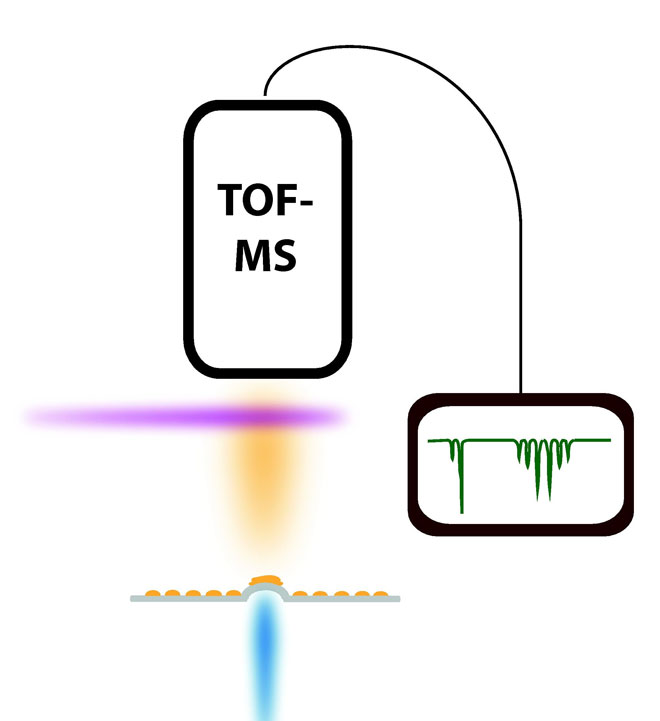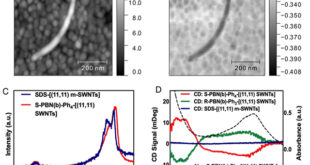Significance Statement
We show that laser-induced acoustic desorption (LIAD) is an interesting tool for analytical and physical chemistry and that it may be considered as a molecular beam method for quantum optics. It allows in particular the generation of slow molecular beams of intact and neutral molecules directly in a high vacuum environment. In our study we have focused on fragile biomolecules and massive tailor-made organic compounds, which can be post-ionized by VUV light at 157 nm. We have combined laser-induced acoustic desorption with VUV post-ionization time of flight mass spectrometry to study molecular beams of chlorophyll a, hemin, bilirubin, and biliverdin as well as high-mass tailor-made porphyrin derivatives. Variations in the molecular fragmentation patterns as a function of both the UV desorption (at 355 nm) and the VUV postionization laser intensity indicates that laser-induced acoustic desorption is a soft method, capable of volatilizing even fragile biomolecules without fragmentation.
We find that laser-induced acoustic desorption produces very slow molecular beams. The final velocity depends on the substrate material and may be up to an order of magnitude slower than for molecules started by matrix assisted laser desorption (MALD). We have observed a most probable velocity of 20 m/s for functionalized porphyrins in the mass range of m = 10 000 Da.
Slow molecular beams are useful for chemistry and physics, in particular for molecular metrology based on beam deflectometry, where the accuracy in determining various molecular properties often scales inversely with the square of the beam velocity, 1/v2. The molecular velocity also determines quantum properties, such as de Broglie’s matter wavelength that is associated with any massive body.
laser-induced acoustic desorption of biliverdin or chlorophyll provides beams with a de Broglie wavelength of λdB = 2 × 10−11 m. This is about ten times longer than in thermal beams of molecules with a similar mass. laser-induced acoustic desorption can be applied to a wide range of particles and it can easily be incorporated into existing analytical MALDI instruments.
Our work has been supported by the European Research Council (Grant 320694), the European Commission (Grant 304886), the Austrian Science Fund (FWF): Grant W1210-3, the Swiss National Science Foundation, as well as the Swiss Nanoscience Institute.
For information on the team, see

Journal Reference
Anal. Chem., 2015, 87 (11), pp 5614–5619.
Uğur Sezer1, Lisa Wörner1, Johannes Horak1, Lukas Felix2, Jens Tüxen2, Christoph Götz3, Alipasha Vaziri3, Marcel Mayor2,4 , Markus Arndt1
[expand title=”Show Affiliations”]- University of Vienna, Faculty of Physics, VCQ & QuNaBioS, Boltzmanngasse 5, 1090 Vienna, Austria
- University of Basel, Department of Chemistry, St. Johannsring 19, 4056 Basel, Switzerland
- University of Vienna, Max F. Perutz Laboratories, Research Institute of Molecular Pathology, QuNaBioS, Doktor-Bohr-Gasse 7, 1030 Vienna, Austria
- Karlsruhe Institute of Technology (KIT), Institute of Nanotechnology, P.O. Box 3640, 76021 Karlsruhe, Germany [/expand]
Abstract
Laser-induced acoustic desorption (LIAD) has recently been established as a tool for analytical chemistry. It is capable of launching intact, neutral, or low charged molecules into a high vacuum environment. This makes it ideally suited to mass spectrometry. LIAD can be used with fragile biomolecules and very massive compounds alike. Here, we apply LIAD time-of-flight mass spectrometry (TOF-MS) to the natural biochromophores chlorophyll, hemin, bilirubin, and biliverdin and to high mass fluoroalkyl-functionalized porphyrins. We characterize the variation in the molecular fragmentation patterns as a function of the desorption and the VUV postionization laser intensity. We find that LIAD can produce molecular beams an order of magnitude slower than matrix-assisted laser desorption (MALD), although this depends on the substrate material. Using titanium foils we observe a most probable velocity of 20 m/s for functionalized molecules with a mass m = 10 000 Da.
Copyright © 2015 American Chemical Society
Go To Anal. Chem
 Advances in Engineering Advances in Engineering features breaking research judged by Advances in Engineering advisory team to be of key importance in the Engineering field. Papers are selected from over 10,000 published each week from most peer reviewed journals.
Advances in Engineering Advances in Engineering features breaking research judged by Advances in Engineering advisory team to be of key importance in the Engineering field. Papers are selected from over 10,000 published each week from most peer reviewed journals.

